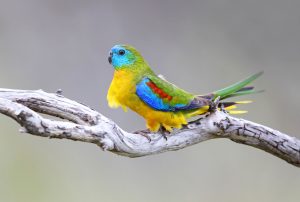By Ian Davidson and Chris Tzaros – Wangaratta Landcare & Sustainability
One of the most spectacular birds occurring in north-east Victoria, the Turquoise Parrot is an iconic species of the region. Preferring lightly-timbered habitats, especially forest edges and clearings, Turquoise Parrots may be moderately common in localised patches around Chiltern, the Warby Ranges and Eldorado hills. However, this wasn’t always the case. Reportedly common around the time of European settlement, this beautiful little parrot suffered a dramatic decline around the beginning of the twentieth century to the point where, around 1920, it was actually considered extinct by many naturalists and ornithologists of the day. The rapid demise was likely a result of profound changes to the species habitat – widespread clearing of woodland vegetation; loss of native grasses and herbs due to the introduction of stock grazing followed by rabbit plagues; severe drought conditions which stripped vegetation back to the ground; and indiscriminate trapping of birds for aviary collections. Fortunately, around the 1950s and 60s, populations began to re-establish in parts of the species range in southern Queensland and inland of the divide in New South Wales. In Victoria, the Warby Ranges was the site of their initial reappearance – a place now considered as a stronghold of the species.
Turquoise Parrots are typically found in pairs or small groups. They are ground feeders that consume small seeds from an array of native grasses, herbs and small shrubs, and often peck seeds off the ground that have fallen from nearby vegetation. As well as native plants, in recent decades the species has adapted to feed on seeds of some introduced weeds such as heliotrope, capeweed and dandelion that occur within their favoured open woodland environs – another potential factor assisting their comeback. As a seed-eater, they need to drink regularly, especially in warmer weather and when parents are feeding young in the nest.
Unlike many other hollow nesting species, Turquoise Parrots prefer low nest sites such as hollow stumps and fence posts with a vertical entrance.
Though there are many other parrots found throughout this region, Turquoise Parrots are identified by their small size, dark green plumage on their upperparts, bright yellow underparts and spectacular blue wings. Males have a distinctive turquoise face and a bright red shoulder blaze and are generally more vividly coloured than females.


